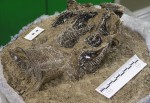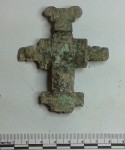 Artifacts from an early Anglo-Saxon settlement have been unearthed at the site of a future housing development in Cherry Hinton, a suburb of Cambridge. Developers Weston Homes hired Oxford Archaeology East to excavate the construction site on the corner of Hatherdene Close and Coldham’s Lane after test pits identified an area of particular archaeological interest. The excavation discovered architectural remains of a village and a range of artifacts from the utilitarian to the rarified.
Artifacts from an early Anglo-Saxon settlement have been unearthed at the site of a future housing development in Cherry Hinton, a suburb of Cambridge. Developers Weston Homes hired Oxford Archaeology East to excavate the construction site on the corner of Hatherdene Close and Coldham’s Lane after test pits identified an area of particular archaeological interest. The excavation discovered architectural remains of a village and a range of artifacts from the utilitarian to the rarified.
 The team unearthed expensive, high-end jewelry including brooches, multi-colored glass, amber beads, rings and hairpins from the 6th century. There were tools including small knives and larger weapons, and intact pottery vases and bowls. The greatest stand-out piece is a glass vessel known as a claw beaker, so named
The team unearthed expensive, high-end jewelry including brooches, multi-colored glass, amber beads, rings and hairpins from the 6th century. There were tools including small knives and larger weapons, and intact pottery vases and bowls. The greatest stand-out piece is a glass vessel known as a claw beaker, so named  because of the H.R. Giger-like claw-shaped handles attached to the conical walls. The glass is tinted amber or brown. These vases were very highly prized, probably imported from Germany, and have mainly been found as grave goods in 5th and 6th century Anglo-Saxon burials.
because of the H.R. Giger-like claw-shaped handles attached to the conical walls. The glass is tinted amber or brown. These vases were very highly prized, probably imported from Germany, and have mainly been found as grave goods in 5th and 6th century Anglo-Saxon burials.
Duncan Hawkins, Head of Archaeology and Build Heritage for CgMs, said: “Evidence of the time period 5th to 7th century AD is almost non-existent so this gives us a highly important window into understanding how people lived in that era, their trade activities and behaviours.
“The academic value of this collection is therefore immeasurable. The site fell out of use in the 7th century but we discovered evidence of 8th century Middle Saxon activity including post-built structures, possibly workshops and livestock pens.
“Pits dug in this attest to local industrial activity and further processing of soil samples should help us understand what these were used for.”
 The excavation also unearthed Roman dishware, early Roman kilns and a network of Late Iron Age and Roman boundary ditches. After the Middle Saxon settlement, there was a manor house built on the site in the 9th or 10th century. In the 11th century, Hinton Manor was one of several Cambridgeshire holdings of Edith the Fair, aka Edith Swanneck, first wife of Harold II. They were married in accordance with the more danico, a traditional Norse form of marriage, which is why nobody raised the bigamy issue when Harold married a Welsh princess in a Christian ceremony in 1066. Edith is best known for having identified Harold’s mutilated body after the Battle of Hastings, ostensibly from marks that only she knew he had on his chest. (One 19th century poet alleged they were hickeys.)
The excavation also unearthed Roman dishware, early Roman kilns and a network of Late Iron Age and Roman boundary ditches. After the Middle Saxon settlement, there was a manor house built on the site in the 9th or 10th century. In the 11th century, Hinton Manor was one of several Cambridgeshire holdings of Edith the Fair, aka Edith Swanneck, first wife of Harold II. They were married in accordance with the more danico, a traditional Norse form of marriage, which is why nobody raised the bigamy issue when Harold married a Welsh princess in a Christian ceremony in 1066. Edith is best known for having identified Harold’s mutilated body after the Battle of Hastings, ostensibly from marks that only she knew he had on his chest. (One 19th century poet alleged they were hickeys.)
 The town of Cherry Hinton appears in the Domesday Book (1086) listed as “Hintone: Count Alan. 4 mills.” Count Alan was Alan Rufus, a kinsman of William the Conqueror’s who fought with him at the Battle of Hastings. After the Norman Conquest, he took Hinton Manor from Edith. He got the lion’s share of her properties, in fact, sweeping up all but one of her Cambridgeshire estates.
The town of Cherry Hinton appears in the Domesday Book (1086) listed as “Hintone: Count Alan. 4 mills.” Count Alan was Alan Rufus, a kinsman of William the Conqueror’s who fought with him at the Battle of Hastings. After the Norman Conquest, he took Hinton Manor from Edith. He got the lion’s share of her properties, in fact, sweeping up all but one of her Cambridgeshire estates.
The housing development of 60 homes will still be built on the site. All the artifacts have been recovered. They will be documented, conserved and exhibited in local museums.
They used this -almost certainly- for apple cider or beer. Some Germans serve ‘Apfelwein’ by the ‘Bembel‘ (a specific Apfelwein jug), much like how beer can be purchased by the pitcher in many countries.
The stuff is then usually consumed in a ‘Geripptes‘, a glass with a lozenge cut that refracts light and improves grip -a holdover from the past, when some meals were traditionally eaten without cutlery. Here, the ‘claw beaker’ comes into play.
Beer, however, made from malted barley, was a favourite drink of the Angles, Saxons and Franconians. A convivial party is sometimes referred to as Gebeórscipe, usually with beór-setl (beer-benches). Particularly, Anglo-Saxon beórsele (i.e. ‘beer-halls’) are not to be confused with a beórtún (i.e. an ‘enclosed beergarden’).
Galloping off to Google H.R. Giger (ah, “Alien”!) and more danico (of course, Rollo and Poppa). Great post. :hattip:
I once heard a speaker who began “1066 is a year noted in history for the introduction of Norman cider apples into England”.
“All the artifacts have been recovered”? How could they possibly know?
The developer says “This will be a chance for homebuyers to feel part of a piece of Britain’s ancient history on a very special site.” Maybe the new rage will be for upscale housing developments built over destroyed archaeological treasures. How very special for the proud owners!
Wow. Not only do you have the best site, you have the best commenters as well. Yours is one of the only blogs I follow, that I read the comments on – usually polite and with additional interesting information. Thank you! I would have loved to hear that speech about 1066 and the apples…
Rupert Brooke:
For Cambridge people rarely smile,
Being urban, squat and packed with guile;
….
Strong men have run for miles and miles,
When one from Cherry Hinton smiles.